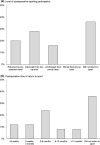Outcome following mini-open lower limb fasciotomy for chronic exertional compartment syndrome
- PMID: 33675406
- PMCID: PMC8741684
- DOI: 10.1007/s00590-021-02919-z
Outcome following mini-open lower limb fasciotomy for chronic exertional compartment syndrome
Abstract
Purpose: The aim of this study was to report outcomes following mini-open lower limb fasciotomy (MLLF) in active adults with chronic exertional compartment syndrome (CECS).
Methods: From 2013-2018, 38 consecutive patients (mean age 31 years [16-60], 71% [n = 27/38] male) underwent MLLF. There were 21 unilateral procedures, 10 simultaneous bilateral and 7 staged bilateral. There were 22 anterior fasciotomies, five posterior and 11 four-compartment. Early complications were determined from medical records of 37/38 patients (97%) at a mean of four months (1-19). Patient-reported outcomes (including EuroQol scores [EQ-5D/EQ-VAS], return to sport and satisfaction) were obtained via postal survey from 27/38 respondents (71%) at a mean of 3.7 years (0.3-6.4).
Results: Complications occurred in 16% (n = 6/37): superficial infection (11%, n = 4/37), deep infection (3%, n = 1/37) and wound dehiscence (3%, n = 1/37). Eight per cent (n = 3/37) required revision fasciotomy for recurrent leg pain. At longer-term follow-up, 30% (n = 8/27) were asymptomatic and another 56% (n = 15/27) reported improved symptoms. The mean pain score improved from 6.1 to 2.5 during normal activity and 9.1 to 4.7 during sport (both p < 0.001). The mean EQ-5D was 0.781 (0.130-1) and EQ-VAS 77 (33-95). Of 25 patients playing sport preoperatively, 64% (n = 16/25) returned, 75% (n = 12/16) reporting improved exercise tolerance. Seventy-four per cent (n = 20/27) were satisfied and 81% (n = 22/27) would recommend the procedure.
Conclusion: MLLF is safe and effective for active adults with CECS. The revision rate is low, and although recurrent symptoms are common most achieve symptomatic improvement, with reduced activity-related leg pain and good health-related quality of life. The majority return to sport and are satisfied with their outcome.
Keywords: Exertional compartment syndrome; Lower limb fasciotomy; Mini-open; Minimally invasive; Patient-reported outcomes; Return to sport.
© 2021. The Author(s).
Conflict of interest statement
The authors declare that they have no conflict of interest.
Figures






References
MeSH terms
LinkOut - more resources
Full Text Sources
Other Literature Sources

